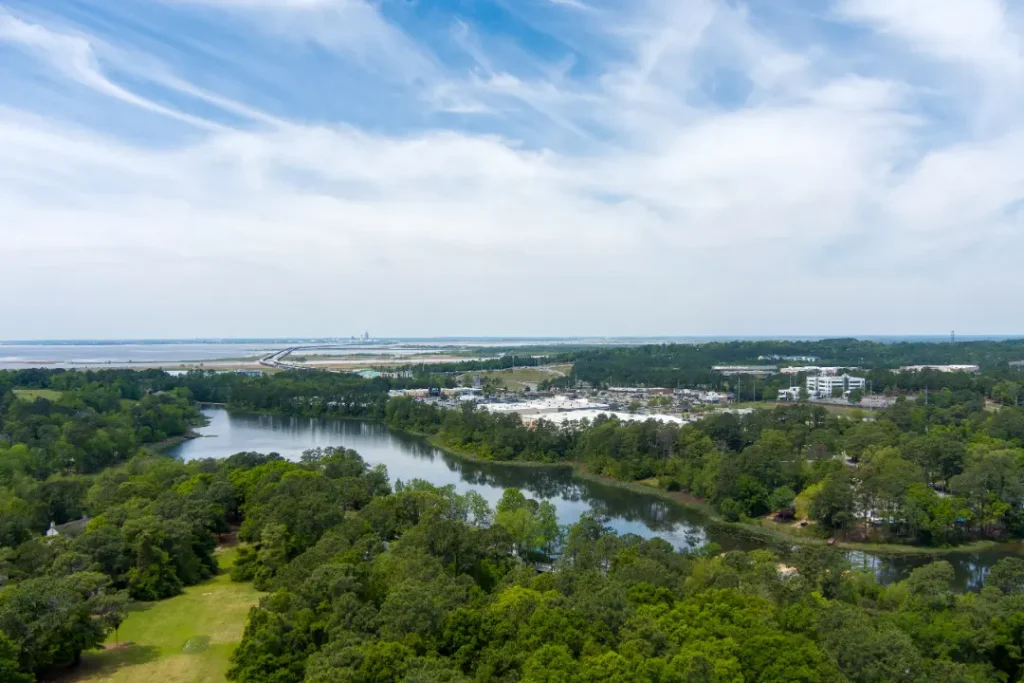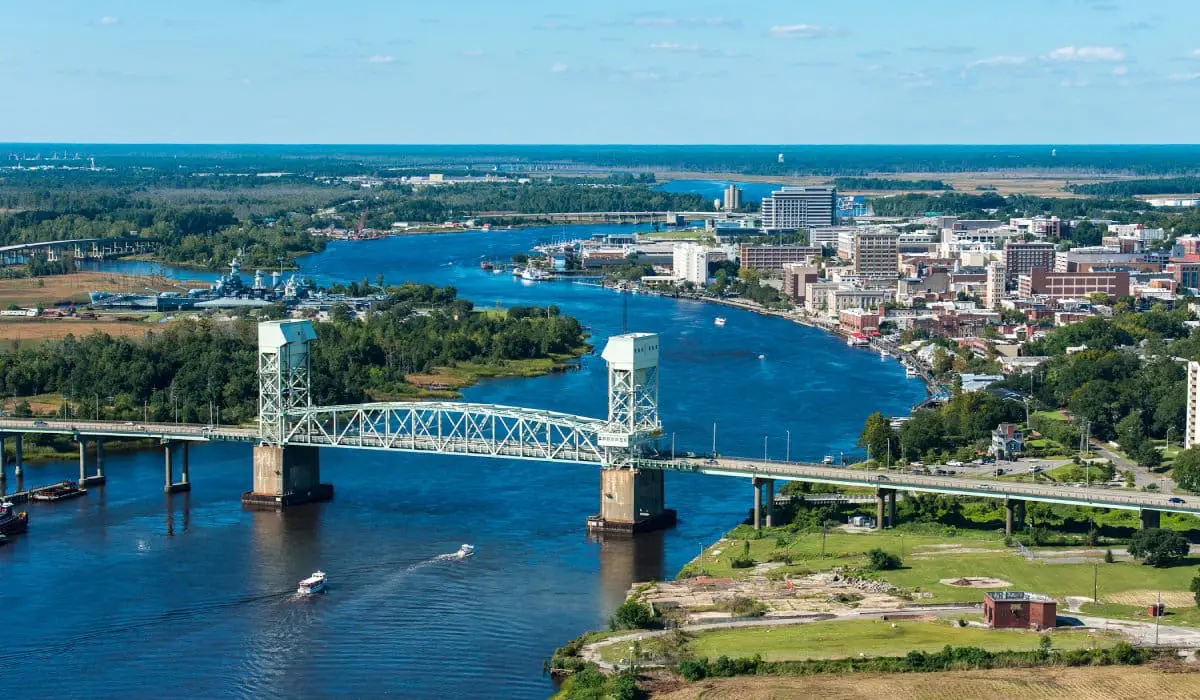Wilmington, NC, is uniquely positioned between the Cape Fear River and the Atlantic Ocean. This article covers how the city’s geography, featuring diverse landscapes and beaches, impacts its lifestyle, activities, and economy.
Key Takeaways
- Wilmington’s geographic location between the Cape Fear River and the Atlantic Ocean establishes it as a vital port city, enhancing its appeal for commerce and tourism.
- Wilmington faces challenges related to coastal living, such as hurricanes and flooding, necessitating community involvement in resilience planning and adaptation strategies.
- Xterior LLC offers comprehensive roofing services, including installations, repairs, and weatherproofing, alongside expert siding, gutter, and window solutions to protect and enhance your home in Wilmington, NC.
Coastal Location of Wilmington
Wilmington’s geographic charm lies in its strategic position between the Cape Fear River and the Atlantic Ocean. This unique location establishes it as a quintessential port city in coastal southeastern North Carolina Wilmington, blending maritime history with modern-day allure. The Cape Fear River serves as Wilmington’s lifeblood, central to its waterfront, and crucial for commerce and recreation.
Perched on a peninsula, Wilmington is surrounded by water, creating an environment that is both picturesque and functional. Classified as a port city, Wilmington is significant in regional trade and transportation, and its coastal setting attracts tourists and nature enthusiasts alike. This duality of purpose and beauty makes Wilmington a standout on the East Coast.
Wilmington’s location near the Atlantic Ocean and the Cape Fear River places it at the heart of North Carolina’s coastal plain and tidewater region. This centrality not only defines its geographical identity but also influences the lifestyle and activities of its residents. From bustling downtown Wilmington to serene coastal communities, the city’s location offers a diverse array of experiences.
Scenic views, thriving port activities, and recreational opportunities all make Wilmington’s coastal setting integral to its character. It’s a place where the natural and urban landscapes coexist, providing a unique backdrop for everyday life.

Diverse Landscapes
A tapestry of diverse landscapes contributes to Wilmington’s unique charm. Situated on a peninsula surrounded by water bodies like the Atlantic Ocean and Cape Fear River, Wilmington blends natural beauty with urban sophistication. From the stunning beaches to the lush riverfront parks and vibrant urban spaces, Wilmington has something for everyone.
Wilmington’s appeal lies in its balance of coastal elements and urban development. The city is adorned with island beaches, marshlands, and urban parks, offering a variety of outdoor environments. This diversity is a significant part of Wilmington’s allure, drawing tourists and residents to explore its many attractions, including Wilmington College.
One of the city’s notable attractions is Airlie Gardens, a historic public garden that showcases the area’s natural beauty with its sprawling landscapes and seasonal blooms. The gardens are a testament to Wilmington’s ability to blend natural and urban elements seamlessly. Visitors can stroll through the gardens, enjoying the harmonious mix of native flora and artistic installations.
Wilmington’s landscapes are integral to the city’s identity. Its historic downtown, featuring a charming riverfront and well-preserved buildings, offers a glimpse into the past while providing modern amenities and attractions. This juxtaposition of old and new is part of what makes Wilmington so captivating.
Wilmington’s varied landscapes support activities ranging from leisurely park walks to adventurous water sports on the beaches. Whether you’re exploring the historic places listed on the national register or enjoying a meal at one of the many waterfront restaurants, Wilmington’s landscapes provide the perfect backdrop for every experience.
Beaches of Wilmington
The beaches are the crown jewels of Wilmington’s coastal allure. Famous for their pristine sands and clear waters, Carolina Beach, Kure Beach, and Wrightsville Beach offer unique experiences for visitors and residents alike. Far from mere relaxation spots, these beaches cater to diverse interests and activities.
Carolina Beach is famous for its bustling boardwalk, amusement rides, and lively atmosphere. It’s a place where you can feel the pulse of the coastal community, with numerous restaurants, shops, and entertainment options right by the shore. Nearby Carolina Beach State Park offers a tranquil escape with scenic trails and opportunities for camping and fishing.
Kure Beach, on the other hand, offers a more laid-back environment. It’s perfect for those looking to escape the hustle and bustle and enjoy some quiet time by the sea. Home to Fort Fisher, a significant Civil War site, this beach adds a historical dimension to your visit.
Wrightsville Beach is perhaps the most popular among locals and tourists alike. With over eight miles of unspoiled beach and marshland, it’s an ideal spot for water activities such as surfing, paddleboarding, and kayaking. The beach is also known for its vibrant community events and family-friendly atmosphere, making it a favorite destination year-round.
Safety remains a top priority on Wilmington’s beaches. Whether you’re looking to soak up the sun, explore the natural beauty, or engage in exciting water sports, Wilmington’s beaches have something for everyone.
The Role of the Cape Fear River
The Cape Fear River serves as a lifeline for Wilmington. Running through the heart of the city, this significant river shapes Wilmington’s geography, economy, and history. Central to Wilmington’s identity, the river provides a vital transportation route for commerce and trade.
Historically, the Cape Fear River has played an instrumental role in Wilmington’s development within the Cape Fear region. It served as a crucial access point for early settlers, offering resources and transportation options that were essential for survival and growth. During the Civil and Revolutionary Wars, the river was strategic, with Wilmington’s port serving as a key location for military operations and trade.
Today, the Cape Fear River remains a significant economic driver for the region. It hosts the Port of Wilmington, the busiest port in North Carolina. This makes Wilmington a hub for maritime commerce, connecting the city to global markets and playing a crucial role in the local economy.
Beyond its economic importance, the river provides recreation and enjoyment for Wilmington’s residents. It supports various activities, from boating and fishing to scenic riverfront walks. Its expansive basin, the largest in North Carolina, shapes the region’s geography and provides a natural habitat for diverse wildlife.
The Cape Fear River exemplifies Wilmington’s integration of natural resources into city life. It’s a place where history meets modernity, and commerce coexists with leisure, making Wilmington a truly unique coastal city.

Impact of Geography on Lifestyle and Activities
Wilmington’s coastal and riverine geography profoundly influences the lifestyle and activities of its residents. Proximity to the Atlantic Ocean and Cape Fear River creates an environment supporting diverse water-based activities and outdoor experiences. Whether it’s surfing, paddleboarding, fishing, or diving, Wilmington offers activities for every water enthusiast.
Local waterways are essential for the variety of water sports in Wilmington. Surfing and paddleboarding thrive on the oceanfront, while the calmer river and marsh waters are perfect for kayaking and fishing. These activities go beyond recreation; they represent a way of life deeply ingrained in Wilmington’s culture.
Wilmington’s beaches are famous for offering diverse experiences. Whether you prefer the lively atmosphere of Carolina Beach’s boardwalk or the serene natural settings of Kure Beach and Wrightsville Beach, there’s a spot for every preference. More than sunbathing spots, the beaches serve as hubs where families gather, friends socialize, and individuals find solace in nature.
The interaction between land and ocean creates unique weather patterns impacting outdoor experiences. In summer afternoons, a refreshing sea breeze often sweeps through Wilmington, providing relief from the heat and enhancing outdoor enjoyment. This natural phenomenon is just one example of how the city’s geography shapes daily life.
Beyond recreation, Wilmington’s geography influences its maritime industries like fishing, boating, and tourism. These industries are vital to the local economy and offer numerous job opportunities for residents. The city’s connection to the water is not just about leisure; it’s an integral part of its identity and economic vitality.
Challenges of Coastal Living
Coastal living in Wilmington comes with its share of challenges. Proximity to the Atlantic Ocean necessitates preparedness for weather-related issues like hurricanes and flooding. Such natural events can significantly impact daily life and demand a proactive approach to safety and preparedness.
Managing these challenges relies heavily on community involvement. Accurate data collection and flood monitoring heavily depend on residents’ reports. This collaborative effort aids city governments and organizations in effectively planning and responding to coastal hazards.
The NC Resilient Coastal Communities Program is crucial for helping local areas develop resilience strategies. Focusing on community engagement and risk assessment, this program informs resilience planning. Involving the community in planning ensures the strategies developed are practical and effective.
Besides hurricanes, Wilmington’s coastal environment faces challenges from tropical storms and constant erosion threats. These issues demand ongoing attention and adaptation to protect the city’s infrastructure and residents. Despite these challenges, the spirit of southern hospitality and community resilience shines, making Wilmington a supportive and dynamic place to live.

Xterior LLC: Reliable Choice for Expert Roofing in Wilmington, NC
In a city facing coastal challenges, having a dependable home services provider is essential. Xterior LLC stands out as Wilmington’s trusted roofing and exterior home services company, dedicated to delivering lasting roofing solutions for local homeowners. Our commitment to quality and customer satisfaction has established us as a preferred choice in the Wilmington area.
At Xterior LLC, we offer a complete roof installation services.. Understanding the unique climate challenges of southeastern North Carolina, we provide tailored solutions designed to withstand harsh weather conditions.
In addition to our roofing services, we also specialize in storm damage restoration—crucial in a coastal city like Wilmington, where severe weather can strike unexpectedly. Our swift and reliable repairs help homeowners safeguard their properties, giving you peace of mind.
But we don’t stop at roofing. Xterior LLC also excels in the installation of siding, as well as gutter installation and replacement. Our dedication to quality and transparent project processes means you’ll receive top-notch service every step of the way.
Frequently Asked Questions
What makes Wilmington, NC, unique in terms of geography?
Wilmington’s unique geography, situated between the Cape Fear River and the Atlantic Ocean, offers a distinctive combination of coastal and urban environments that greatly enhance its charm and lifestyle.
What are some popular beaches in Wilmington?
Carolina Beach, Kure Beach, and Wrightsville Beach are some of the most popular beaches in Wilmington, each providing distinct attractions and recreational opportunities.
How does the Cape Fear River impact Wilmington?
The Cape Fear River significantly influences Wilmington’s economy and geography by acting as a crucial transportation route and enhancing recreational opportunities for residents and visitors alike.
What challenges do residents of Wilmington face due to its coastal location?
Residents of Wilmington confront significant challenges like hurricanes, flooding, and tropical storms, necessitating strong community engagement and effective resilience strategies to mitigate these risks.
Summary
Wilmington, North Carolina, is a city where the natural beauty of coastal landscapes harmonizes with the vibrancy of urban life. Its unique geography—encompassing stunning beaches, the vital Cape Fear River, and diverse landscapes—shapes the lifestyle and activities of its residents. The challenges of coastal living are addressed through innovative adaptation and resilience strategies, ensuring Wilmington remains a thriving and dynamic place to call home.
Local businesses like Xterior LLC play a crucial role in supporting the community by providing essential services that help residents protect and maintain their homes. As you explore Wilmington’s coastal wonders and urban landscapes, you’ll discover a city that embraces its natural surroundings while effectively meeting the challenges of coastal living. Whether you’re visiting or planning to settle down, Wilmington offers an enriching experience that seamlessly blends history, nature, and modernity in a truly unique way.




